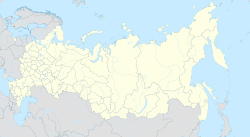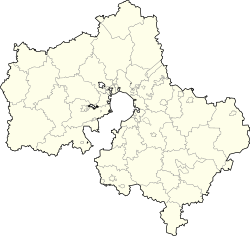world.wikisort.org - Russia
Balashikha (Russian: Балашиха, IPA: [bəlɐˈʂɨxə]) is a city in Moscow Oblast, Russia, located on the Pekhorka River 1 kilometer (0.62 mi) east of the Moscow Ring Road.
This article uses bare URLs, which are uninformative and vulnerable to link rot. (August 2022) |
Balashikha
Балашиха | |
|---|---|
City[1] | |
 Clockwise: Lenina Avenue, Balashikha-Arena, Balashikha railway station. Balashikha cotton mill #1 | |
 Flag  Coat of arms | |
Location of Balashikha  | |
 Balashikha Location of Balashikha  Balashikha Balashikha (Moscow Oblast) | |
| Coordinates: 55°49′N 37°58′E | |
| Country | Russia |
| Federal subject | Moscow Oblast[1] |
| Founded | 1830[2] |
| City status since | 1939 |
| Government | |
| • Body | Council of Deputies |
| • Head | Sergey Yurov |
| Area | |
| • Total | 244.18 km2 (94.28 sq mi) |
| Elevation | 150 m (490 ft) |
| Population | |
| • Total | 215,494 |
| • Estimate (2018)[5] | 468,221 (+117.3%) |
| • Rank | 86th in 2010 |
| • Density | 880/km2 (2,300/sq mi) |
Administrative status | |
| • Subordinated to | Balashikha City Under Oblast Jurisdiction[1] |
| • Capital of | Balashikha City Under Oblast Jurisdiction[1] |
Municipal status | |
| • Urban okrug | Balashikha Urban Okrug[3] |
| • Capital of | Balashikha Urban Okrug[3] |
| Time zone | UTC+3 (MSK |
| Postal code(s)[7] | 143xxx |
| Dialing code(s) | +7 495 |
| OKTMO ID | 46704000001 |
| Website | www |
Etymology
In Finno-Ugric languages,[which?] Bala-shika means land of celebrations, land of laughter and fun.[8] Finnic peoples lived in this area before Slavs.
Geography
The city is known for its unique river and waterway system. The Pekhorka River system covers an area of 40 kilometers (25 mi) from north to south and 20 kilometers (12 mi) from east to west, and many small lakes and ponds were created by damming to provide water power for the cotton mills in the 19th century.
History
Balashikha was established in 1830.[2] It was granted town status in 1939.[9] Several rural hamlets had existed long before on the site of the modern city.
The city stands on the famous Vladimir Highway, which led out of Moscow to the east. This was the route along which convicted criminals were marched to forced labor camps in Siberia. The road was renamed Gorky Highway in the Soviet era. The failure of the Decembrist Revolt against Tsar Nicholas I led to the execution of its ringleaders and the exile of many nobles to Siberia. Soviet-era schoolchildren were told that the prisoners were marched in chains along this road followed by their wives. In truth, the Decembrist prisoners were sent from St. Petersburg, then the capital of Russia, through Yaroslavl, and not through Moscow and Balashikha, and the story was invented as part of celebrations of the 100th anniversary of the event in 1925.
Between 1830 and 1870, a cotton factory was in operation in the area, with its fabric called Balashikha. A railway station was built at the end of the 19th century, again called Balashikha Station.
As it grew, Balashikha absorbed other villages, including Gorenki, a suburban estate of Count Andreas Razumovsky, and Pekhra-Yakovlevskoye, an estate of Prince Galitzine, the latter being in use for 250 years from 1591 to 1828. This is the site of a stone church, built from 1777 to 1782.
Saltykovka, a part of Balashikha, has long been known for its attractions to the artistic community. Isaak Levitan, the famous landscape painter, lived there in 1879. Lev Tolstoy was another frequent visitor.
Soviet period
Several institutions were founded in Balashikha after the October Revolution, including one dedicated to the production of fur.
During the Soviet era, Balashikha became a major industrial center with industries in metallurgy, aviation industry, cryogenic technology, machinery, and other fields.
Balashikha sent many of its sons to the front to fight the Germans during World War II. Among those who fought and died was Ivan Flerov who commanded a Katyusha rocket division and is remembered by several monuments and museums in the area.
Along with many other Russian Orthodox Churches, the Cathedral of Saint Alexander Nevsky was demolished by the government. The Cathedral was blown up in the 1960s but was rebuilt, on its original site, in 2002.
Modernity
The Balashikha Maternity House was designated on July 1, 2003, to be the Moscow Oblast Perinatal Center. This facility will now function as a regional perinatal care facility for high-risk mothers and infants and a perinatal health education center for Moscow Oblast.
Although not part of the extensive Moscow subway system, Balashikha is home to many office workers who commute to Moscow each day. It has several thriving markets and retail centers and is quickly modernizing. It is surrounded by attractive woodland and countryside.
In January 2015, the city of Zheleznodorozhny was abolished with its territory merged into Balashikha.
Administrative and municipal status
Within the framework of administrative divisions, it is, together with twelve rural localities, incorporated as Balashikha City Under Oblast Jurisdiction—an administrative unit with the status equal to that of the districts.[1] As a municipal division, Balashikha City Under Oblast Jurisdiction is incorporated as Balashikha Urban Okrug.[3]
In the past, Balashikha served as the administrative center of Balashikhinsky District. On January 1, 2011, the district was abolished.
Sport
The 2017 national rink bandy cup took place in Balashikha.[10][11][12]
Culture

The city is home to several music schools, including the Sviridov School of Arts. Attractions include the Balashikha Arena and Moscow Radio Center 13.
Military
Balashikha is the site of a large Russian Army base and was closed to foreigners during the Soviet era, a ban which, in theory, remains to the present day.[citation needed] It was the headquarters of the 1st Corps of the Soviet Air Defense Forces and is now to become the headquarters of the Operational-Strategic Command for Missile-Space Defense. Balashikha is also a base for ODON (Internal security division). Balashikha is home to Military Unit 35690, which is a training facility used by the Federal Security Service.[13]
Notable people
- Yuri Lyapkin (born 1945), ice hockey player
- Nikolay Baskov, tenor singer
- Dmitry Klokov, Honored Master of Sports in weightlifting
- Andrey Kuznetsov, tennis player
- Artyom Avanesyan, Armenian footballer
Twin towns – sister cities
Balashikha is twinned with:[14][15]
References
Notes
- Law #11/2013-OZ
- Энциклопедия Города России. Moscow: Большая Российская Энциклопедия. 2003. p. 35. ISBN 5-7107-7399-9.
- Law #208/2014-OZ
- Russian Federal State Statistics Service (2011). Всероссийская перепись населения 2010 года. Том 1 [2010 All-Russian Population Census, vol. 1]. Всероссийская перепись населения 2010 года [2010 All-Russia Population Census] (in Russian). Federal State Statistics Service.
- http://www.msko.gks.ru/wps/wcm/connect/rosstat_ts/msko/resources/c7954d80450b9e608f41afde4cdebdf4/Оценка+численности+постоянного+населения+Московской+области+по+состоянию+на+1+января++2018+г.doc.
- "Об исчислении времени". Официальный интернет-портал правовой информации (in Russian). June 3, 2011. Retrieved January 19, 2019.
- Почта России. Информационно-вычислительный центр ОАСУ РПО. (Russian Post). Поиск объектов почтовой связи (Postal Objects Search) (in Russian)
- "Топонимия Балашихи". Archived from the original on July 26, 2010. Retrieved October 17, 2011.
- Balashikha. Official page. History.
- "Кубок России по мини-хоккею с мячом - 2017 - Соревнования - Федерация хоккея с мячом России".
- https://translate.google.co.uk/translate?hl=en&sl=ru&u=http%3A%2F%2Fwww.rusbandy.ru%2Fnews%2F11118%2F
- "Кубок России по мини‐хоккею с мячом стартовал в Балашихе". Телеканал 360°.
- Bellingcat Investigation Team (February 17, 2020). ""V" For "Vympel": FSB's Secretive Department "V" Behind Assassination of Georgian Asylum Seeker in Germany". bellingcat.
Most frequent were Krasikov’s visits to FSB’s highly secure Special Operations Center in Balashiha, a suburb just outside Moscow. This heavily guarded facility, known as Military Unit 35690, was the original military base for the KGB’s Vympel Spetsnaz unit, and now serves as headquarters for the FSB’s CSO, as well the home-base of the elite and secretive Departments V and A.
- "Сергей Юров предложил создать группу по работе с городами-побратимами". balashiha.ru (in Russian). Balashikha. September 9, 2017. Retrieved February 4, 2020.
- "Балашиха и китайский Янчжоу будут сотрудничать в экономике и культуре". balashiha.ru (in Russian). Balashikha. April 13, 2018. Retrieved February 4, 2020.
Sources
- Московская областная Дума. Закон №11/2013-ОЗ от 31 января 2013 г. «Об административно-территориальном устройстве Московской области», в ред. Закона №249/2019-ОЗ от 29 ноября 2019 г. «О внесении изменений в Закон Московской области "Об административно-территориальном устройстве Московской области"». Вступил в силу на следующий день после официального опубликования (13 января 2013 г.). Опубликован: "Ежедневные Новости. Подмосковье", №24, 12 февраля 2013 г. (Moscow Oblast Duma. Law #11/2013-OZ of January 31, 2013 On the Administrative-Territorial Structure of Moscow Oblast, as amended by the Law #249/2019-OZ of November 29, 2019 On amending the Law of Moscow Oblast "On the Administrative-Territorial Structure of Moscow Oblast". Effective as of the day following the day of the official publication (January 13, 2013).).
- Московская областная Дума. Закон №208/2014-ОЗ от 30 декабря 2014 г. «О преобразовании городского округа Балашиха и городского округа Железнодорожный, о статусе и установлении границы вновь образованного муниципального образования», в ред. Закона №52/2015-ОЗ от 13 апреля 2015 г. «О внесении изменения в Закон Московской области "О преобразовании городского округа Балашиха и городского округа Железнодорожный, о статусе и установлении границы вновь образованного муниципального образования"». Вступил в силу через 10 дней после официального опубликования, за исключением статей 4 и 5, вступающих в силу через один месяц после вступления в силу настоящего Закона в случае отсутствия инициативы жителей Городского округа Балашиха о проведении местного референдума по вопросу определения структуры органов местного самоуправления Городского округа Балашиха. Опубликован: Официальный Интернет-портал Правительства Московской области (http://www.mosreg.ru), 30 декабря 2014 г. (Moscow Oblast Duma. Law #208/2014-OZ of December 30, 2014 On Transforming the Urban Okrug of Balashikha and the Urban Okrug of Zheleznodorozhny, on the Status and the Border of the Newly Established Municipal Formation, as amended by the Law #52/2015-OZ of April 13, 2015 On Amending the Law of Moscow Oblast "On Transforming the Urban Okrug of Balashikha and the Urban Okrug of Zheleznodorozhny, on the Status and the Border of the Newly Established Municipal Formation". Effective as of the day which is 10 days after the official publication, with the exception of Articles 4 and 5, which take effect one month after this Law takes effect, providing the lack of initiative of the urban okrug residents to conduct a local referendum on the subject of establishing the structure of the bodies of local self-government of Balashikha Urban Okrug.).
Further reading
- "Balashikha in stories" (Балашиха в очерках и зарисовках) - А. Галанин и др.
External links
- Official website of Balashikha (in Russian)
- Directory of organizations in Balashikha (in Russian)
На других языках
[de] Balaschicha
Balaschicha (russisch Балашиха) ist eine Großstadt in der Oblast Moskau in Russland. Sie liegt etwa 25 km östlich des Stadtzentrums und vier Kilometer von der Stadtgrenze Moskaus, am Moskwa-Nebenfluss Pechorka. 2015 wurde sie mit der benachbarten Großstadt Schelesnodoroschny zusammengeschlossen, wobei letztere als Verwaltungseinheit erlosch. Mit nunmehr 423.946 Einwohnern (Stand: 1. Januar 2015)[2] ist Balaschicha die bevölkerungsreichste Stadt der Oblast.- [en] Balashikha
[ru] Балашиха
Балаши́ха[прим 1][5][6] — город в России, в центре Московской области, крупнейший город области. Образует город областного подчинения с административной территорией и одноимённое муниципальное образование городской округ Балашиха. Основан в 1830 году. Население города составляет 520 962[3] чел. (2021).Другой контент может иметь иную лицензию. Перед использованием материалов сайта WikiSort.org внимательно изучите правила лицензирования конкретных элементов наполнения сайта.
WikiSort.org - проект по пересортировке и дополнению контента Википедии